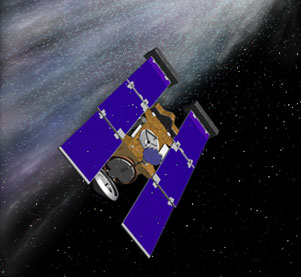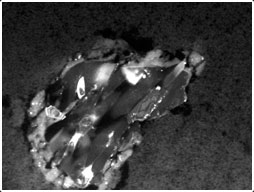
 |
 |
 |
|
Stardust's sample collector(Courtesy of NASA)
 |
|
|
 |
|
|
Samples captured in aerogel in the collector(Courtesy of NASA)
 |
|
|
 |
|
|
A comet particle collected by Stardust. NASA has confirmed finding minerals such as olivine, which are formed in high heat, in the comet dust.(Courtesy of NASA) |
|
|

 |
Sample return missions are quite difficult. With Stardust, for instance, we had many technical obstacles to overcome.
We had to reboot the software when a problem occurred at the beginning of the flight, and once the probe had to be switched to safe mode because of the interference from solar wind [a large quantity of charged particles emitted by a solar flare].
The hardest thing was our return through Earth's atmosphere. Stardust used a silicon material called aerogel for collecting comet dust, and we had to ensure the capsule was strong enough to protect the precious samples stuck in the catcher. The capsule entered the atmosphere at a speed of 46,400 km/h, which is the fastest of any artificial entity on entering into the atmosphere, so extremely high thermal resistance was required.
We had to have a very rugged thermal protection system. And the timing of hitting the atmosphere, opening our drogue chute and then opening our main parachute - these were all critical functions. Fortunately for us they all worked perfectly, and we landed very softly in the desert in Utah.
Like all projects, Stardust was built upon our previous experience. We know how to model Earth's atmosphere very accurately. We've had all of the Apollo and early Mercury flights, all the flights that went outside the atmosphere and came back, and the shuttle flights, so we have all of this knowledge on Earth's atmosphere. Knowing our trajectory, we could predict what the peak temperatures would be, what the peak velocities and speeds would be, and we knew exactly where to deploy our drogue chute and our main chute. And when we came in perfectly, all of these models and these dozens and dozens of years of experience with space exploration were proven to be correct. |
 |
The concept for a Stardust mission was originally based on collecting the interstellar dust that flows through our solar system. This was being considered in the mid-1980s. However, in the late 1980s and 1990s, we determined that we could actually get to this new comet, Wild 2, which now came in as close as the orbit of Mars. And so the focus went from collecting just interstellar dust to collecting cometary dust as well. This concept really became solid in the early 1990s.
The original proposal for Stardust was around 1994. At that time, the Discovery program was in progress under the NASA slogan "Faster, Better, Cheaper," and 30 to 50 proposals were submitted. We made our presentations to NASA headquarters, and in 1996 NASA gave us the approval to continue with the development of the project. So it was a very, very strong competition, but Stardust was selected, and as we know now, after the mission's success, NASA was brilliant in that decision. |
 |
| I was very closely associated with the Genesis mission, which collected solar particles. It orbited near the liberation point between the Earth and the sun, and stayed there for a few years collecting solar particles. It returned to Earth in September 2004, but after its parachute system failed to deploy, it landed harder than expected in the Utah desert. Fortunately, the samples were extracted from the space capsule, which was spared from damage, and they are currently being analyzed at the Johnson Space Center. It's unfortunate that when people saw the hard landing they thought this might have meant failure. It absolutely was not. That was just a stopping place. The finish line for Genesis, as well as for Stardust, is at Johnson, where the science people are studying the particles. |
|
|